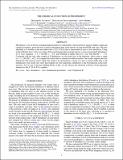| dc.contributor.author | Jacobson, Heather | |
| dc.contributor.author | Thanathibodee, Thanawuth | |
| dc.contributor.author | Roederer, Ian U. | |
| dc.contributor.author | Cescutti, Gabriele | |
| dc.contributor.author | Matteucci, Francesca | |
| dc.contributor.author | Frebel, Anna L. | |
| dc.date.accessioned | 2015-02-20T17:49:27Z | |
| dc.date.available | 2015-02-20T17:49:27Z | |
| dc.date.issued | 2014-11 | |
| dc.date.submitted | 2014-09 | |
| dc.identifier.issn | 2041-8213 | |
| dc.identifier.issn | 2041-8205 | |
| dc.identifier.uri | http://hdl.handle.net/1721.1/95453 | |
| dc.description.abstract | Phosphorus is one of the few remaining light elements for which little is known about its nucleosynthetic origin and chemical evolution, given the lack of optical absorption lines in the spectra of long-lived FGK-type stars. We have identified a P I doublet in the near-ultraviolet (2135/2136 Å) that is measurable in stars of low metallicity. Using archival Hubble Space Telescope-Space Telescope Imaging Spectrograph spectra, we have measured P abundances in 13 stars spanning –3.3 ≤ [Fe/H] ≤ -0.2, and obtained an upper limit for a star with [Fe/H] ~ -3.8. Combined with the only other sample of P abundances in solar-type stars in the literature, which spans a range of –1 ≤ [Fe/H] ≤ +0.2, we compare the stellar data to chemical evolution models. Our results support previous indications that massive-star P yields may need to be increased by a factor of a few to match stellar data at all metallicities. Our results also show that hypernovae were important contributors to the P production in the early universe. As P is one of the key building blocks of life, we also discuss the chemical evolution of the important elements to life, C-N-O-P-S, together. | en_US |
| dc.description.sponsorship | National Science Foundation (U.S.) (Grant AST-1255160) | en_US |
| dc.description.sponsorship | Massachusetts Institute of Technology. Undergraduate Research Opportunities Program | en_US |
| dc.language.iso | en_US | |
| dc.publisher | IOP Publishing | en_US |
| dc.relation.isversionof | http://dx.doi.org/10.1088/2041-8205/796/2/l24 | en_US |
| dc.rights | Article is made available in accordance with the publisher's policy and may be subject to US copyright law. Please refer to the publisher's site for terms of use. | en_US |
| dc.source | American Astronomical Society | en_US |
| dc.title | THE CHEMICAL EVOLUTION OF PHOSPHORUS | en_US |
| dc.type | Article | en_US |
| dc.identifier.citation | Jacobson, Heather R., Thanawuth Thanathibodee, Anna Frebel, Ian U. Roederer, Gabriele Cescutti, and Francesca Matteucci. “THE CHEMICAL EVOLUTION OF PHOSPHORUS.” The Astrophysical Journal 796, no. 2 (November 17, 2014): L24. © 2014 The American Astronomical Society | en_US |
| dc.contributor.department | Massachusetts Institute of Technology. Department of Physics | en_US |
| dc.contributor.department | MIT Kavli Institute for Astrophysics and Space Research | en_US |
| dc.contributor.mitauthor | Jacobson, Heather | en_US |
| dc.contributor.mitauthor | Thanathibodee, Thanawuth | en_US |
| dc.contributor.mitauthor | Frebel, Anna L. | en_US |
| dc.relation.journal | The Astrophysical Journal. Letters | en_US |
| dc.eprint.version | Final published version | en_US |
| dc.type.uri | http://purl.org/eprint/type/JournalArticle | en_US |
| eprint.status | http://purl.org/eprint/status/PeerReviewed | en_US |
| dspace.orderedauthors | Jacobson, Heather R.; Thanathibodee, Thanawuth; Frebel, Anna; Roederer, Ian U.; Cescutti, Gabriele; Matteucci, Francesca | en_US |
| dc.identifier.orcid | https://orcid.org/0000-0003-4507-1710 | |
| dc.identifier.orcid | https://orcid.org/0000-0001-7727-1640 | |
| dc.identifier.orcid | https://orcid.org/0000-0002-2139-7145 | |
| dspace.mitauthor.error | true | |
| mit.license | PUBLISHER_POLICY | en_US |
| mit.metadata.status | Complete | |
